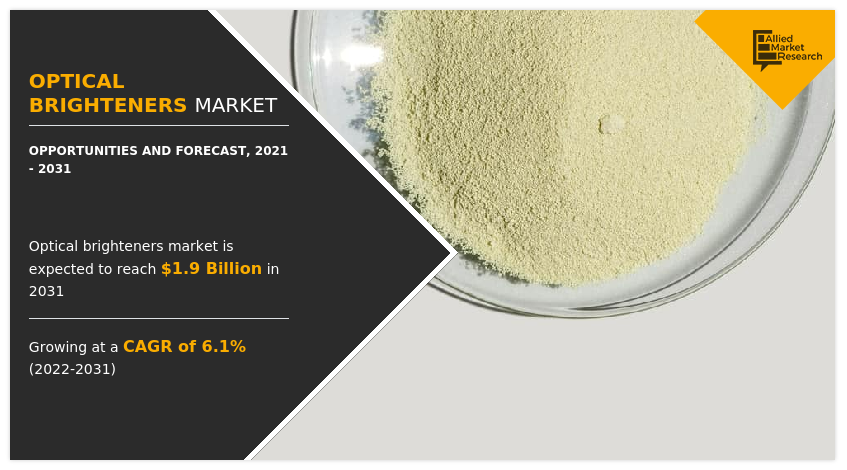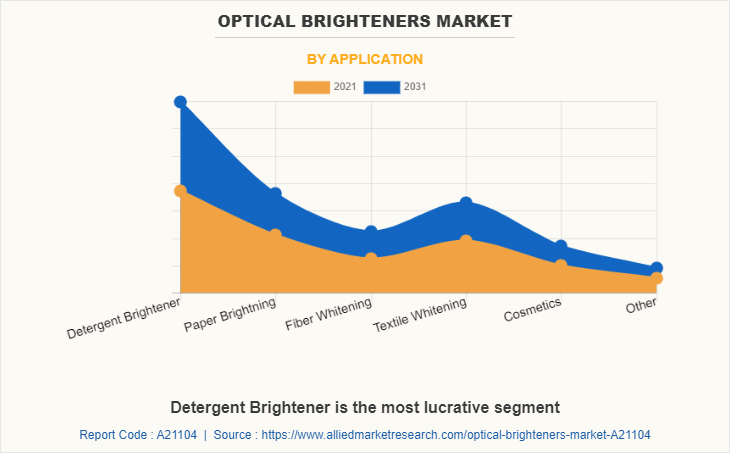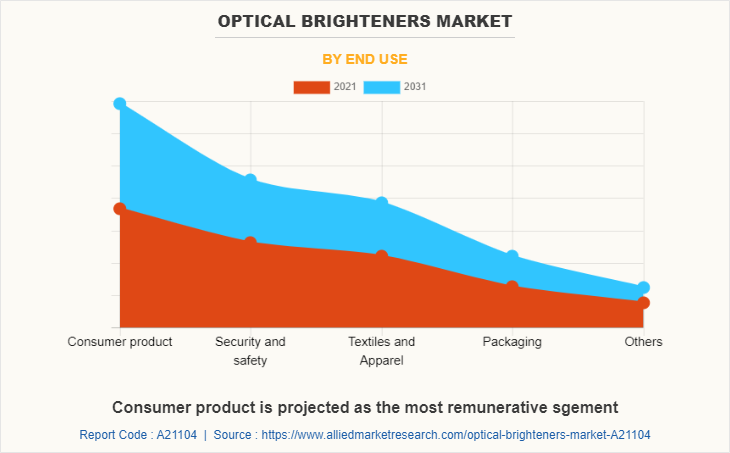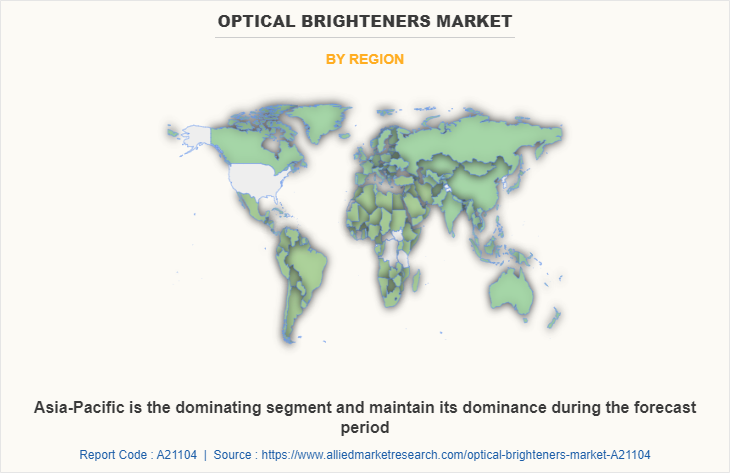Optical Brighteners Market Research, 2031
The global optical brighteners market size was valued at $1.1 billion in 2021, and is projected to reach $1.9 billion by 2031, growing at a CAGR of 6.1% from 2022 to 2031.
Optical brighteners are also identified as fluorescent whitening agent, brightening agent, hydrophilic water soluble compounds, and chemical agent. They are mainly derivatives of triazine-stilbenes (di-, tetra- or hexa-sulfonated), coumarins, imidazolines, diazoles, triazoles, benzoxazolines, biphenyl-stilbenes, and others. They are used in various end use industry including paper, packaging, textile, cosmetics, and others owing to less toxicity and whitening agent.

The rapid increase in the population in both developed and developing economies, rise in import and export of various cosmetics and skincare products, and increased focus on the cosmetic sector has increased the demand for optical brighteners where optical brighteners act as a color-correcting and brightening additives in various skin care and personal care products such as shampoo, conditioners, eyes make up products, concealer, and many others. These factors act as a key driver responsible for the growth of optical brighteners in the market.
In U.S. Food and Drug Administration (FDA) has set some standard limits on the use of optical brighteners in food packaging products. In addition, availability of alternative eco-friendly and biodegradable brighteners is most preferred by consumer which will expected to disturb the potential sales of optical brightness. These factors together are expected to hamper the optical brightener market growth
The rise in demand for paper-based packaging material, availability of raw material, and ease of operation has surged the packaging industry where optical brighteners are extensively as a brightening agent to achieve complete white papers. Raw materials of papers contains impurity such as snippet wood and bamboo sticks as to obtain clear white paper optical brighteners are used thus, the demand for optical brighteners has increased. These factors are predicted to contribute to the market growth and are anticipated to offer new opportunities in the global optical brighteners market.
The optical brightener market analysis is done on the basis of application, end use, and region. By application, it is divided into detergent brightener, paper brightening, fiber whitening, textile whitening, cosmetics, and other. By end use, it is classified into consumer product, security and safety, textiles and apparel, packaging, and other. Region-wise, the market is studied across North America, Europe, Asia-Pacific, and LAMEA.
The global optical brightener market forecast include profiles of leading players that include Archroma, BASF SE, Blankophor GmbH & Co. KG , Clariant AG, Dayglo Color Corp, Huntsman Corporation, Meghmani Group, NANJING LEPUZ CHEMICAL CO., LTD., Pylam Products Company, Inc., and Shandong Raytop Chemical Co., Ltd. The global optical brightener market report provides in-depth competitive analysis as well as profiles of these major players.

In 2021, the detergent brightener segment was the largest revenue contributor, and is anticipated to grow at a CAGR of 6.6% during the forecast period. The derivatives of optical brighteners such as distyryl biphenyl (DSBP) and anionic diamino stilbene are extensively used as detergent brighteners which helps in keeping the clothes clean and bright. Moreover, optical brightener offers an advanced solutions as compared to bluing & bleaches in laundry detergent process, which has increased the demand for optical brighteners in the market.

By end use, the consumer products segment dominated the global market in 2021, and is anticipated to grow at a CAGR of 6.7% during forecast period. The utilization of optical brightener has been increased in consumer products owing to its brightening, fluorescent agent. It is used in a wide range of products intended for home appliances such as detergents, liquid soap, shampoo, and conditioner products for grey and blonde hair. Furthermore, derivatives of optical brighteners such as stilbene, coumarins, imidazolines, diazoles, and others are extensively used in the consumer products that includes laundry detergent which helps in increasing the brightness of clothes. These factors are coupled together to increase the potential sales of optical brightener in consumer products sector.

The Asia-Pacific optical brightener market size is projected to grow at the highest CAGR of 6.3% during the forecast period, with 41% major share in the global market. This is attributed to proliferating demand from textile sector where optical brighteners are used as brightening and fluorescent agent for finishing of textile. 41% major share in the global market. This is attributed to proliferating demand from textile sector where optical brighteners are used as brightening and fluorescent agent for finishing of textile. In addition, the rise in disposable income among people, growing focus in the cosmetics and personal are sector has spurred the growth of cosmetics sector where optical brighteners has been used widely as a brightening additive and color-correcting or in advanced cosmetics formulas that includes, shampoo, creams, eye makeup, and other products. These factors are driving the growth of optical brightener market in Asia-Pacific region.
IMPACT OF COVID-19 ON THE GLOBAL OPTICAL BRIGHTENER MARKET
- The optical brighteners market has staggering and unprecedented impact due to the wake of the COVID-19 pandemic, owing to the disruptions in the supply chain for various optical brightener products.
- Sluggish manufacturing activities have led to decrease in the demand for optical brighteners during 2020.
- The guidelines and policies of logistics and supply chain of the optical brighteners and chemical market were affected remarkably. Moreover, the supply of optical brightener products to marketers and consumers are held both within and across the border during the first quarter of 2020.
- Furthermore, several personal care and beauty care products including fragrances, colon cosmetics, skincare, haircare, has been affected owing to strict government norm and regulation
- Furthermore, to control the surge of novel coronavirus cases, there is a drastic shift of investments from other sectors toward cosmetics, medical, textile, and among others. Also, several optical brightener’s product manufacturing companies have either shut down or shrank their operations due to the risk of infection among the workforce.
- This has temporarily hampered the demand and supply chain of optical brighteners market. In addition, complete imposition of lockdown in textile, rubber, packaging, consumer products, and other end use sector are being lifted in the year 2021 and growth of optical brighteners market will come to its original pattern.
- However, growing awareness related to health and sustainable development has surged production of optical brighteners during the COVID-19 pandemic which in turn has increased the demand for optical brighteners products.
- As the restrictions imposed due to lockdowns are being lifted in the fourth quarter of the pandemic, the cosmetics, medical, pharmaceuticals, automotive, and other sector is expected to recover soon owing to the record of production unit in both developed and developing economies.
Key Benefits For Stakeholders
- This report provides a quantitative analysis of the market segments, current trends, estimations, and dynamics of the optical brighteners market analysis from 2021 to 2031 to identify the prevailing optical brighteners market opportunities.
- The market research is offered along with information related to key drivers, restraints, and opportunities.
- Porter's five forces analysis highlights the potency of buyers and suppliers to enable stakeholders make profit-oriented business decisions and strengthen their supplier-buyer network.
- In-depth analysis of the optical brighteners market segmentation assists to determine the prevailing market opportunities.
- Major countries in each region are mapped according to their revenue contribution to the global market.
- Market player positioning facilitates benchmarking and provides a clear understanding of the present position of the market players.
- The report includes the analysis of the regional as well as global optical brighteners market trends, key players, market segments, application areas, and market growth strategies.
Optical Brighteners Market Report Highlights
| Aspects | Details |
| By Application |
|
| By End use |
|
| By Region |
|
| Key Market Players | BASF SE, milliken & company, EASTMAN CHEMICAL COMPANY, Huntsman International LLC, AKZO NOBEL N.V., Aron Universal Limited,, Teh Fong Min International Co., Ltd., Archroma Management LLC, Clariant Chemicals (India) Ltd, RPM International Corp |
Analyst Review
According to CXOs of leading companies, the global optical brighteners market is expected to exhibit high growth potential. Optical brighteners are also known as fluorescent agent, whitening agent, and has an ability to absorb light and re-emit into blue visible light; owing to these properties it is extensively used in the chemical, cosmetics, textile, packaging and other end use sectors.
In addition, optical brighteners have excellent absorption capacity and it is resistant to chemical and temperature and has been used predominantly in personal care, cosmetics, packaging, printing processing, and many others which will surge the demand for optical brighteners in upcoming years. Furthermore, the non-toxic property of optical brighteners enable the consumers to use them in the cosmetics industry for formulations of shampoo, conditioner, face creams, eye makeup, and other skin care products.
The CXOs further added that sustained economic growth and the development of the cosmetics and textile sector have surged the popularity of optical brighteners.
Consumer products industry is projected to increase the demand of optical brighteners market
The growth of the optical brighteners market is driven by the rise in population, increase in disposable income, and the growing cosmetics and personal care industry which has surged the demand for optical brighteners.
The detergent brightener segment dominated the global market in 2021. The detergent brighteners are growing at a rapid pace owing to the rise in population, increase in disposable income, and consumers rising preferences for bright color clothes due to which derivatives of optical brighteners are used widely as a detergent brighteners.
The global optical brighteners market was valued at $1.1 billion in 2021, and is projected to reach $1.9 billion by 2031, growing at a CAGR of 6.1% from 2022 to 2031.
Archroma, BASF SE, Blankophor GmbH & Co. KG , Clariant AG, Dayglo Color Corp, Huntsman Corporation, Meghmani Group, NANJING LEPUZ CHEMICAL CO., LTD., Pylam Products Company, Inc., and Shandong Raytop Chemical Co., Ltd.
Rise in population, increase in fashion consciousness among people, and adoption of western culture have spurred the textile industry. For instance, according to an article published by India Brand Equity Foundation in March 2022, the Indian textiles market is expected to be worth more than US$ 209 billion by 2029 where optical brighteners have been applied on cotton fabrics as a whitening agent, protective and coating material for leather, various types of fabrics, yarn, and others. It also acts against the yellowish color of the fabric and pours out blue light rays which will ultimately help in maintaining the quality of fabrics and increases the durability of clothes. This is projected to enhance the demand for optical brighteners in the textile industry.
The optical brightener market analysis is done on the basis of application, end use, and region. By application, it is divided into detergent brightener, paper brightening, fiber whitening, textile whitening, cosmetics, and other. By end use, it is classified into consumer product, security and safety, textiles and apparel, packaging, and other. Region-wise, the market is studied across North America, Europe, Asia-Pacific, and LAMEA.
Loading Table Of Content...



